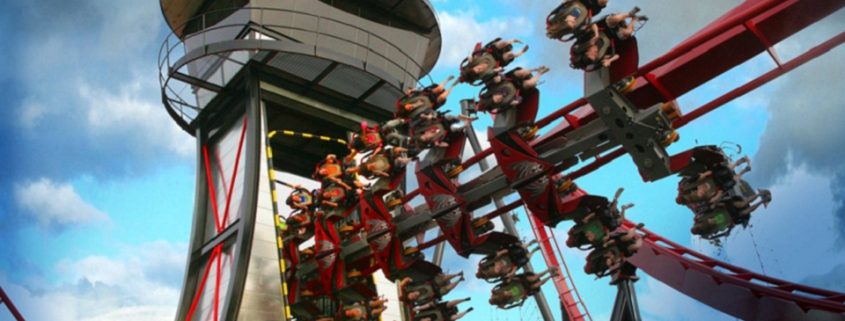Amusement Rides Trends
Amusement rides have changed a lot in the last century. Did you ride the Little Dipper wooden roller coaster at Kiddieland Amusement Park in Melrose Park? Originally built in 1950 by Philadelphia Toboggan Coasters, the Little Dipper was an awesome amusement ride!
When we were kids, the American Eagle at Six Flags Great America in Gurnee was the tallest, fastest wooden roller coaster. More than 25 years later, the Eagle remains one of our favorite amusement rides. Manufactured by Intamin and built in 1981, this ride was integrated into the park by Tom Bleck, who remembers the excitement of working on the project. At the time, Bob was 19 and working for Tom. He vividly remembers the long, white-knuckle walk up to the top of the track. We still have a hand-drawn copy of the Eagle layout at our office in Libertyville.
These days, amusement rides have even more to offer in terms of theming and variety, technological advancements, and guest comfort and safety. The new introductions are a reminder of the attractions industry’s commitment to innovation, excitement and fun!
At IAAPA’s fall amusement trade industry show, we saw lots of cool new ride technologies and products that are worth sharing.
- Ride enhancements are being introduced at a rapid pace. These include structural enhancing, vibration dampening materials. Three-wheeled devices lock the cars to the tracks and enable the cars to turn and twist, moving in ways that were previously unimaginable. New pneumatic systems and linear electric motors add to the options available to ride designers. Six Flags Great America’s Goliath will be the world’s fastest wooden coaster with the tallest and steepest drop, plunging riders down 180 feet at a breathtaking 72 miles per hour.
- Materials advancements have made an enormous improvement in amusement ride construction and guest enjoyment. The development of advanced materials has also given designers the tools to create ever more complex and precise rides. Lightweight plastics and fiberglass are used in a variety of rides from bumper cars to carousels. Material advancements that benefit roller coaster rides include polyurethane wheels on tubular steel tracks, making for a more comfortable, wilder ride experience.
- Redundant safety mechanisms and fail-safe systems ensure rider safety in case of an emergency event or malfunction. Designers have developed ride padding, head rests, and ratcheted restraints in order to create safer, more comfortable rides. Safety improvements that riders may not notice are the hidden technological advancements in computer controls and magnetic braking systems.
- Exciting amusement ride theming, motion simulation, mobile device interaction, and special effects have contributed enormously to improved guest experiences.
- Advanced computer modeling is used to design rides and layouts and allows engineers to predict the performance, strength, and integrity of the ride assembly. It accurately predicts the size, movement, pattern, and capacity of the latest rides. Ride fabrication is precisely determined by computer modeling, ensuring tight tolerances and ease of eventual disassembly.
- Computer systems automatically control many of the ride functions and sensors help park personnel to monitor the entire ride. In fact, even complex rides like Six Flag’s Great America’s X-Flight are controlled by one ride operator located high above the track.
These advances allow amusement parks to offer even more in terms of theming and variety, technological advancements, and guest comfort and safety. The result is increased guest excitement and fun!
Still wishing you could have experienced an old-school amusement ride? Take a spin on the charming Little Dipper, which was preserved by Six Flags Great America after Kiddieland Amusement Park closed in 2010. Enjoy!



